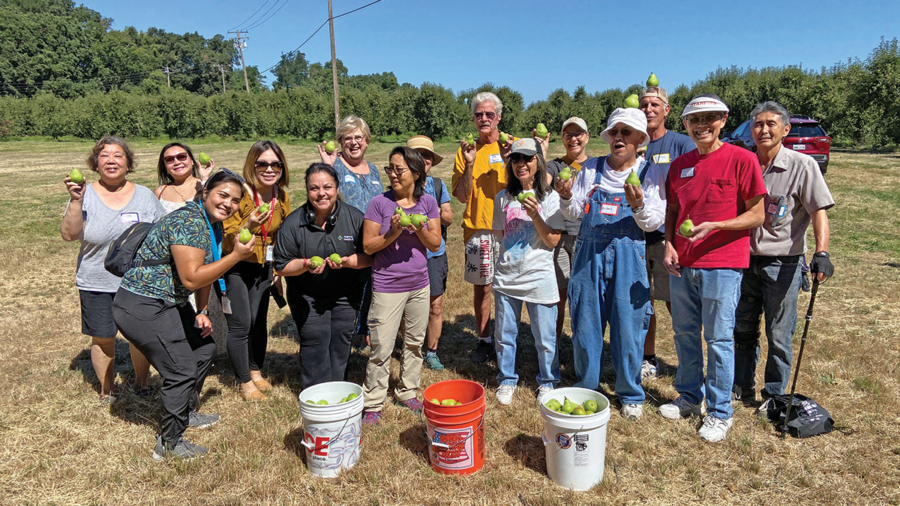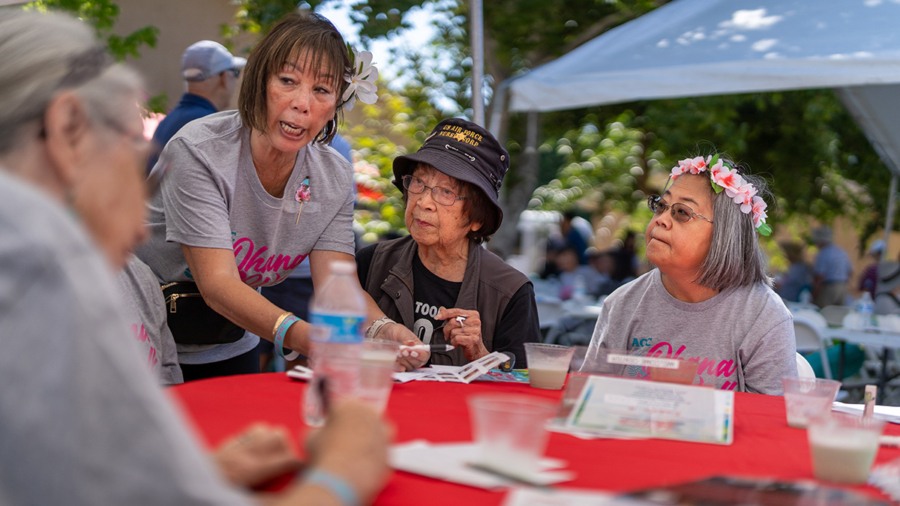The ACC Mah Jong Club meetings Mondays, Wednesdays, and Fridays at ACC. The seven tables fill up quickly. The ladies and a few men settle down in groups of four. Once the “MJ” tiles are “washed,” the game is on! The clicking of tiles is mixed in with laughter and whispers about who makes the best dim sum pastry and the old neighborhood gossip that happened 50 years ago!
Connecting Hearts and Building Health
As someone whose career is deeply rooted in the well-being and healthcare of individuals, my journey into the world of senior care began at ACC Bingo, which meets every Friday. More than a year ago, I began as a player and then as an emcee and caller. It was an unexpected yet incredibly rewarding detour in my career as a dental practice consultant.
Little did I know that this volunteer activity would be fun and interesting for seniors, their caregivers, and the more than 20 volunteers who take turns running the sessions. It opened a doorway to something much more profound – a path filled with heartwarming encounters, remarkable stories, and a unique perspective on social care and its impact on the health and well-being of seniors.
Adventures Beyond Bingo
Earlier this year, ACC asked me to help organize and lead field trips as part of its Lifelong Learning and Wellness program. These have been nothing short of many grand adventures. Our field trips have become a beacon of joy for the attendees, offering them a chance to explore, connect, and rediscover the vibrant spirit of life. I’ve had the pleasure of working with Jeri Shikuma, Dani Lee, Ted Fong, and Dannis Voong on planning these trips.
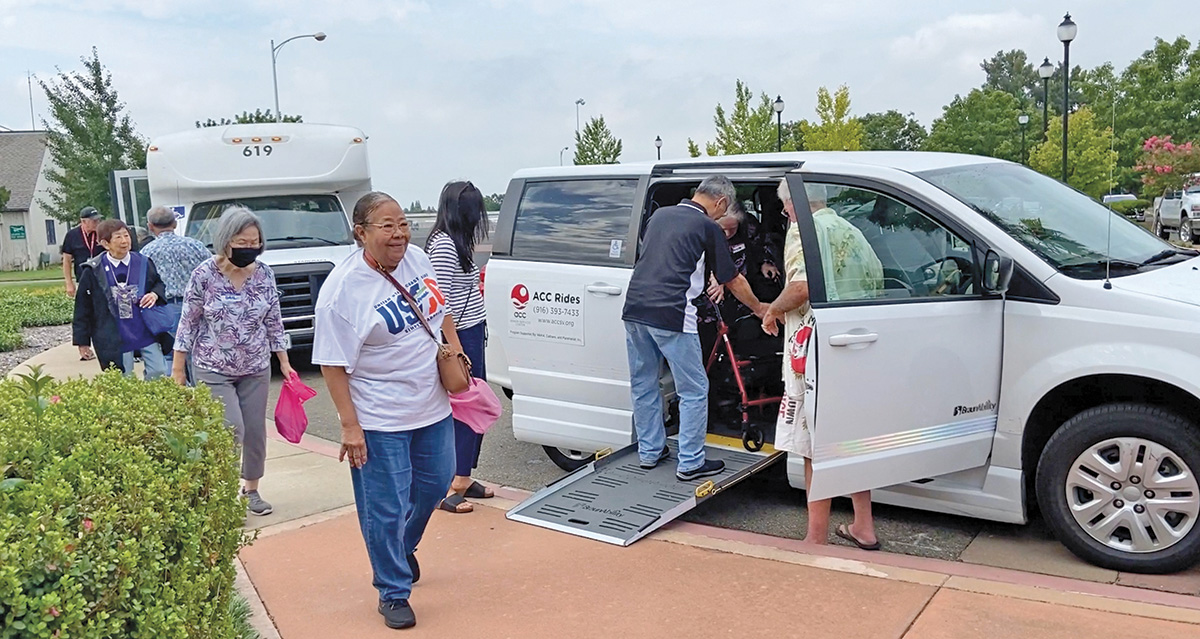
One field trip that stands out is the trip to the city of Locke to pick pears. Our friend and tour guide, Alfred Yee, was a delight to watch, as he interacted with our 30 pear picking participants. Clarence Chu, the owner of the pear farm, generously allowed us to pick as many pears as we wanted. The orchard was beautiful and had not been picked yet. Every single tree was chock full of pears!
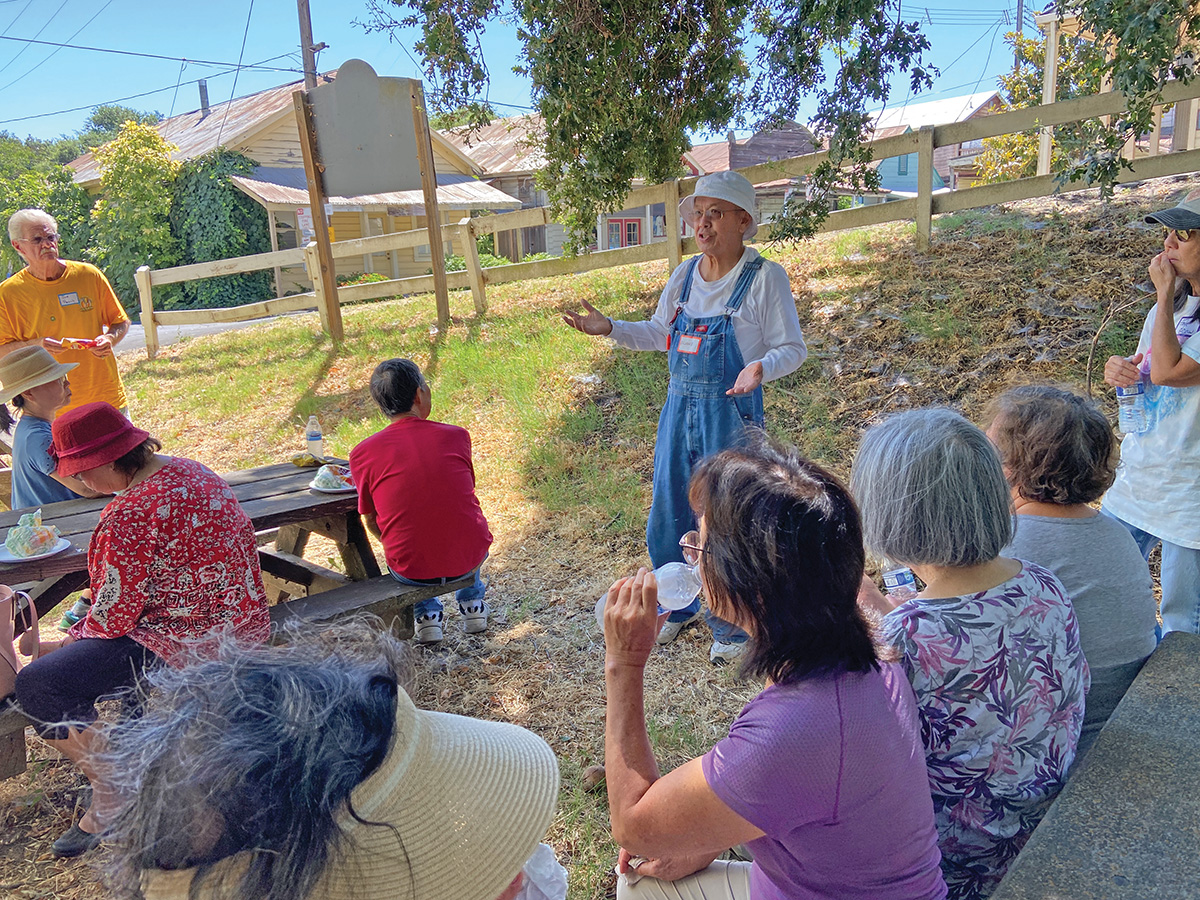
After pear picking, Alfred led us to the front of the Locke Museum and delivered a talk on the history of this Delta town. His childlike curiosity and unbridled enthusiasm were a vivid reminder that age is but a number and the thirst for knowledge knows no bounds. We enjoyed a delightful day, and our minds were stimulated with every pick and conversation.
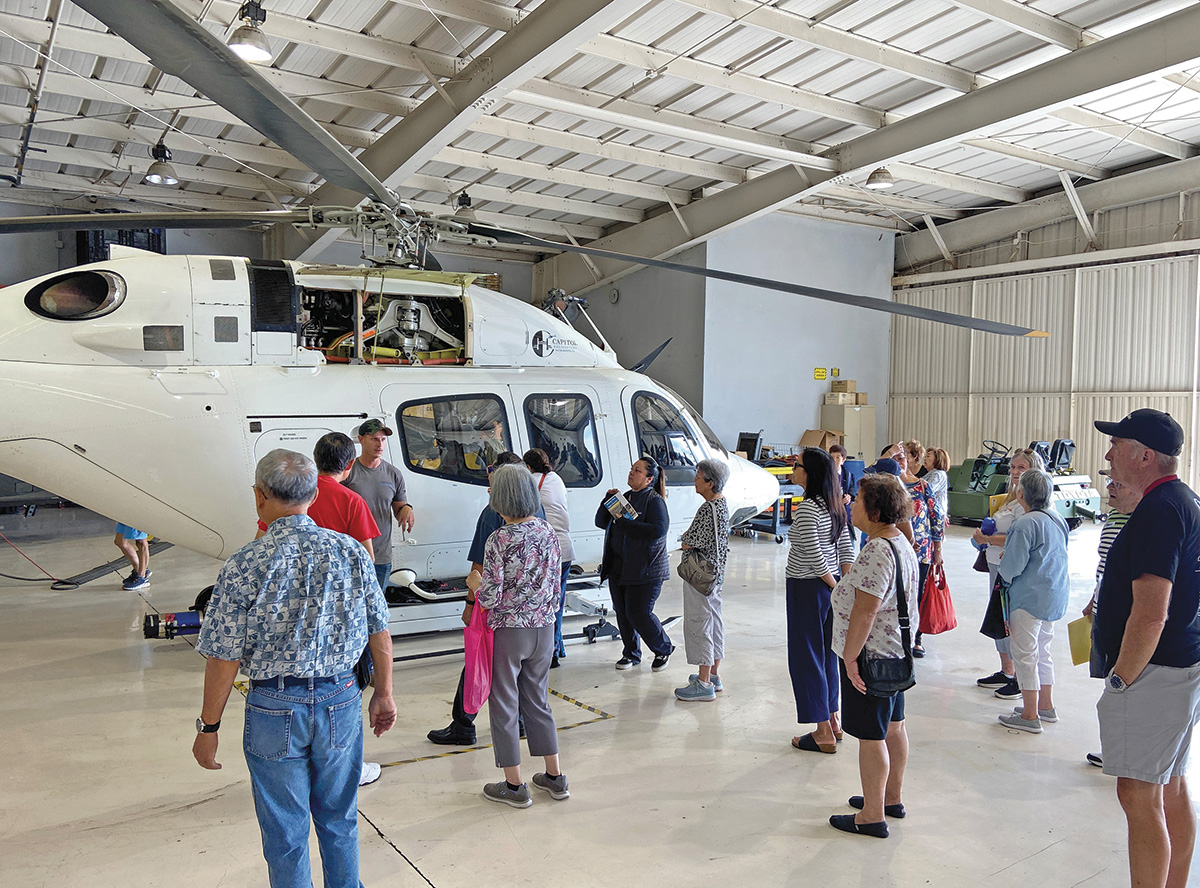
Another field trip was to the Sacramento Executive Airport, where attendees were treated to a behind-the-scenes look at Sacramento’s aviation history. Airport Manager Larry Fleshman and Ann LeBlanc, our knowledgeable guides, made the experience truly unforgettable. We also toured the hangar of Capitol Helicopters and visited a company that installs state-of-the-art instruments in airplanes. There were airplanes everywhere. Then we ate lunch at Aviator’s Restaurant!
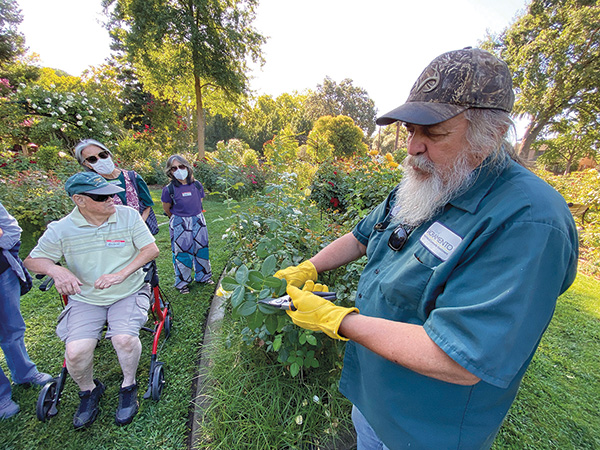
In September, a group of 22 took ACC Rides to visit the picturesque McKinley Rose Garden Park. As we strolled through the garden, I couldn’t help but notice the gleam in everyone’s eyes, the smiles that grew wider with every passing bloom, and the laughter that echoed through the fragrant air. It was a testament to the simple yet profound power of nature to uplift the soul. Then we enjoyed a picnic lunch.
Addressing the Ripple Effects of Isolation on Health
I’ve come to learn that connecting social care with health care is big at ACC Senior Services. Loneliness, especially during the pandemic, is a silent predator that can lead to a cascade of health issues. But by providing seniors with opportunities to engage, socialize, and stay mentally and physically active, we can contribute to a significant reduction in preventable health issues, hospitalizations, and emergency room visits. Ultimately, this leads to healthier, happier, and more resilient seniors who can enjoy a higher quality of life.
My participation in ACC bingo and field trips is a vivid reminder that health care isn’t just about treating diseases, it’s also about nourishing the spirit.
Ohana Walk Embodied The Spirit of Aloha!
On the brisk morning of Saturday, September 16th, 2023, over 700 walkers gathered in the parking lot of ACC Senior Services – ready to take off on their choice of a 1 mile- 2 mile- 3 mile route around the Pocket Canal Parkway.
Glen Shimazu, 102 – Celebrating Our Centenarians
Glen Shimazu grew up on a Delta farm. At age 102, he still loves tending to the vegetable gardens and fruit trees surrounding his home in Sacramento.
Born March 1921 in Sacramento to Japanese immigrant parents, he had two brothers and one sister. An older sister remained in Japan when his parents relocated to California. Glen’s father was the foreman of a pear orchard in Courtland. “It was hard work, picking and packing the fruit by hand. I learned to drive tractors when I was very young,” recalls Glen. Like other Japanese children in the Delta, he attended Bates Oriental School and Holland Japanese School.
Glen was a senior at Courtland High School when his family left for the Gila River internment camp in Arizona. In 1943, everyone in camp was asked to complete a loyalty questionnaire. Glen joined others in responding “no” to certain questions. By doing so, he was identified as being disloyal, aka a “No-No Boy.” His entire family was subsequently transferred to Tule Lake internment camp.
In November 1945, Glen and his father were released from Tule Lake. They returned to Sacramento and stayed in a hostel at Parkview Presbyterian Church. Around 1946, they had saved enough money to rent a house in Hood at a pear orchard. The rest of the family was able to leave Tule Lake internment camp and return to the house in Hood.
The family pooled their resources to purchase seven acres of land in South Sacramento for the purpose of farming. They harvested tomatoes, eggplant, daikon, and cucumbers and sold the crops to local stores. When the family stopped farming, they built homes on the land. Glen still lives in the home he built in 1960.
In the early 1950s, Glen figured he’d better settle down. He was working at McClellan Air Force Base. A mutual friend introduced him to Mary Seno. Raised in Florin, she was working at the Sacramento Army Depot. They married in 1955 and had three children, Yvonne, Dwayne, and Alene. They had 57 years together before Mary passed in 2012.
The couple found time to travel around the world, collecting rocks from every city they visited. Glen proudly showed me their unique rock collection; each rock is engraved with the site and date the couple were there.
What’s his secret to living so long? Glen says maybe it’s because he’s nice to everyone he meets. And he’s done a lot of volunteer work. He was one of the original volunteers with the Meals on Wheels program when ACC took over operations. He used to take a bus to play the slot machines in Reno and Tahoe, but these days, family members drive him to Red Hawk and Sky River casinos. Frequent visits from his children and five grandchildren keep him going.
Yvonne says her dad is a farmer at heart, spending long hours tending his garden and fruit trees. I can vouch for his green thumb – the Chinese long beans he gave me were delicious.
Mickey Yamadera, 102 – Celebrating Our Centenarians
Much has been written about Mickey Yamadera’s many years as a community activist and volunteer with ACC. She recently published Quest for Normalcy, chronicling her early years.
Miyoko Hayashi was born in September 1921 in Gardena, California. She was the third child of five. Her parents immigrated from Japan to farm in southern California. Her father, Jinzo Hayashi, arrived in 1910; her mother, Chito, in 1915.
When Mickey was a young child, both her mother and an infant brother succumbed to pneumonia. Jinzo tried growing vegetables as an independent farmer. His children harvested the crops. Unbeknownst to her, Jinzo “rented” out Mickey to the neighboring Tanaka family, so she could help with their family farm.
Jinzo struggled to feed his children. One day, he tried to steal a neighbor’s chicken and was shot in the arm. Medical complications resulted in him losing his right arm. Unable to work, he then lost his farm. Times were hard; each child was then placed with a different family. Mickey’s last home was with Dr. Mabelle Moore and her husband, Dr. Holbrook Rawson, in Culver City. She was treated very well by the family. Mickey and Aunt Mabe became fast friends.
Mickey graduated from Alexander Hamilton High School in 1940. She recalls going with her sister that summer to a Baptist Camp in Idyllwild Pines. They made new friends there, especially with Japanese boys!
When Pearl Harbor was bombed in 1941, Mickey was on the move again. Her first stop was at the Santa Anita Racetrack Assembly Center, and then to Amache Internment Camp in Colorado. She and her siblings stayed in Block 11G. She worked first as a hospital aide, and next as the Girls’ Recreation Director. When she wasn’t working, she wrote letters to the troops, up to nine letters a day.
In 1943, Mickey left Amache to work as a nurse’s aide in Ann Arbor. This is where she met her future husband, George Yamadera. He was an orderly in surgical services. From Oakland, George’s family was interned at Tule Lake. He stayed at Tule Lake until 1944, when he volunteered for the military. He served with the 442nd Regimental Combat Team and did his tour of duty in France and Italy.
In March 1944, Mickey moved to New York City. She worked in a factory making military hats and did other odd jobs to support herself and the war effort. During this time, Mickey and George were exchanging letters. His letters often mentioned getting married. Mickey finally said “yes,” three days before George was shipped overseas. Coincidentally, George and Mickey’s brother, Kaz, were on the same transport ship headed for Europe.
Mickey and George were married in 1945. Higher education was always important to Mickey; when the war was over, she supported the family while George studied pharmacy at the University of Utah. He graduated in 1957 when their two children, Karen and Richard, were young. He had a long 27-year career as a pharmacist. He and Mickey were married for 65 years before he passed away in 2010.
Mickey characterizes her life as one of perseverance, optimism and grit. Her children, three grandchildren and three great-grandchildren are all very proud of Mickey and all she has accomplished.
###
Related article: Mickey Yamadera, Volunteer’s Life at ACC by Ted Fong
Dorothy Koga, 103 – Celebrating Our Centenarians
Born on May 15, 1920, Dorothy Koga is 103 years young! Dorothy was born in Sacramento with the help of a Japanese midwife who delivered many babies to Japanese parents. Dorothy’s parents were farmworkers who followed and harvested the crops in the Sacramento region. Dorothy remembers her parents placing her near them in a box so that she would not wander off while her parents worked in the fields. Dorothy said that when her parents finished a row of crops, they would move the box over, with Dorothy in it. Dorothy said the box had blankets inside, which made the box comfy.
Dorothy’s parents then moved to Los Angeles, where they lived in a boarding house. Her mother did housecleaning at the boarding house. Eventually, they were given the opportunity to run the produce section at the Piggly Wiggly Market. Her mother used to tell Dorothy that they sold the best produce in Los Angeles. Dorothy went to school in Los Angeles, where she graduated from Manual Arts High School and attended Woodbury Business College before World War II broke out.
During the war, Dorothy’s family was interned at the Amache Internment Camp in Colorado. This is where she met her husband Dix Koga, and they were married there. After Camp, they moved to Walnut Grove, where Dix’s family was from. Before the war, the Koga family had a barbershop, pool hall, and made tofu. After returning to Walnut Grove, Dix cut hair at the barbershop. Dorothy remembers all the shops in Walnut Grove, including the Inaba Grocery Store, Hayashi Market, Oda’s Meat Market, Lim Kee Department Store, and, of course, the Miyazaki candy store.
Dorothy excitedly recalls meeting the singer Bobby Darin when she worked at the Walnut Grove courthouse. During the summers in the Delta, many boat owners would cruise their boats along the Sacramento River and dock in Walnut Grove or in the surrounding sloughs. One summer day, Bobby Darin docked at Walnut Grove, went to the County Courthouse, and asked Judge James Gualco to marry him and Andrea Joy Yeager (his second wife). Judge Gualco told Bobby Darin that he needed a few more documents before he could marry them. Bobby Darin returned in his boat the next day to get married, but they needed a witness. Dorothy, being the Court Clerk, became the witness to the marriage of Bobby Darin (using his real name Walden Robert Cassotto) and Andrea Yeager on June 25, 1973.
Dorothy started working for the county on September 26, 1956 and worked 20 years for the County Courts. She attended many meetings and talked and listened to people with all kinds of stories and problems–which made the job very interesting, rewarding, and educational. Dorothy received a 20-year service pin from Judge Gualco.
Dorothy has three wonderful daughters, Janice, Carolyn, and Sharon, six grandchildren, and 12 great-grandchildren. Dorothy lives at ACC Greenhaven Terrace Assisted Living, where she hangs out with her friends, playing cards, knitting, crocheting, taking walks, and partaking in the many activities offered.
Kiyo Sato, 100 – Celebrating Our Centenarians
Life for Kiyo Sato began May 8, 1923. Delivered by a Japanese-American midwife on the Sato farm in Mather Field, she was the first of three girls and six boys of John Shinji and Mary Tomomi Sato. Life on the 20-acre farm was idyllic; their many crops were in much demand. The King and Queen of England requested crates of the Sato’s raspberries as the royals traveled through Canada; the White House ordered 50 pounds of their walnuts.
In the one-room elementary school, Edward Kelley School, Kiyo and 51 other students were taught by Miss Mary Aline Cox, who attended lovingly to them. Kiyo remembers singing operas and nature walks.
In May 1942, Kiyo, her parents and seven siblings were interned at the Pinedale Assembly Center in Fresno and then the Poston Internment Camp in Arizona. Her brother Steve was in the US Army. Kiyo, age 19, taught the young ones. Internees worked to make the children’s lives as good as possible–everything was “for the sake of the children.” She remembers the outhouse with the wood board with 10 holes, five on each side. Using this was agony for a teen longing for privacy at such times.
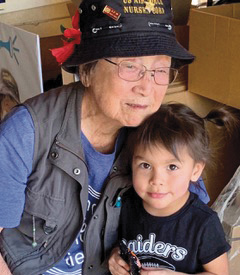
Kiyo wanted to be a nurse. Rejected for her “background” by nursing schools, she attended Columbia University on a scholarship. She later admonished the nursing schools, and they accepted her. Congresswoman Frances Payne Bolton established the Cadet Nurse Corps, which Kiyo attended with free tuition. She obtained her nursing degree there.
A nurse in the Korean War, she next worked for the County of Sacramento, overseeing the health of mothers and children. She made two lifelong friends, Evelyn Loomis and Marie Jenkins. Traveling with Evelyn for 14 months, they worked their way through 13 countries.
She says her parents were her role models, treating everyone with respect. Kiyo married and divorced. During one marriage, Kiyo and her husband adopted four children: Cia, Jon, Paul and Tanya. Raising children alone was a challenge but they are her life’s great joy, and she’s proud of all of them and her five grandchildren and two great-grandchildren.
Her hobbies include hula dancing, tai chi, and writing. Her first book, Dandelion Through The Crack, won major awards. She’s writing a second. She is active in the Nisei VFW speakers’ group, talking about the internment each year to approximately fifty groups, especially children, to help ensure this travesty of justice never happens again.
Dolores Greenslate, 99 – Celebrating Our Centenarians
Birthday cake is always on the Thanksgiving menu at Lynette Bell’s home. That’s because her mother, Dolores Silva Greenslate, was born near the holiday in 1924. Back in those days, the neighborhood was mostly farmland, worked by Portuguese immigrants from the Azores Islands and some Japanese families. Farmhouses were two-story wood buildings with no indoor plumbing. Families raised livestock, chickens, and pigs for food. Lewis Park sits on property formerly owned by her great-grandfather, Antone Rodriques Perry.
Dolores lived with her parents, Victor and Mamie Silva, and her brother, Marvin, on an 80-acre ranch belonging to her grandparents, John and Clara Machado. The ranch wasn’t far from where The Trap sits today. Her grandparents planted vegetable gardens and fruit trees.
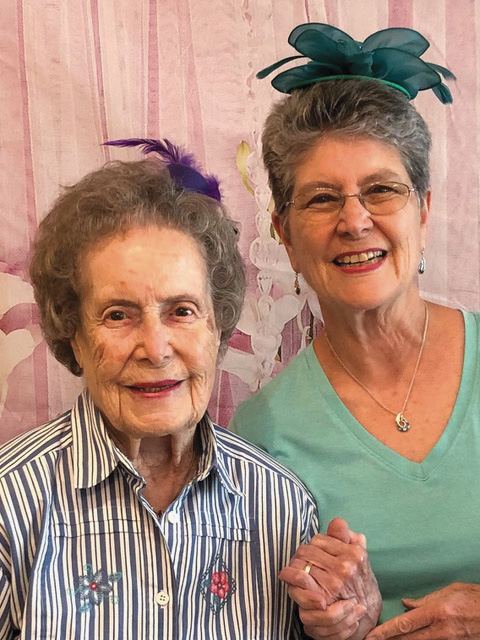
Dolores liked to stand on the levee to watch the ferryboats. “They came so close, I could talk with the passengers,” she recalls. At Sutter School (now site of the Cabrillo Club), she remembers learning “bad words” from her Japanese classmates. She was a teen when she met Norman Greenslate. They both went to California Junior High, C.K. McClatchy High School, and Sacramento City Junior College. Norm liked Dolores, but his second love was baseball, and he was very good. He was scouted by the St. Louis Cardinals and the Chicago White Sox, but World War II interrupted his baseball plans. He served with the 398th Army Engineers and was photographed at the Battle of the Bulge. Ken Burns used this photo in his documentary film and book entitled The War.
Dolores did her part in the war effort by growing a victory garden and entertaining troops at USO dances. Lynette says her mother loves to jitterbug. Dolores is also in the Burns film, recounting when she sent a pin-up picture of herself to Norm, so he wouldn’t forget her. He certainly didn’t. They married in 1946. Norm played in local softball leagues and, years later, was inducted into Sacramento’s La Salle Baseball Hall of Fame. He passed away in 2017 at the age of 93.
In 1962, they moved into the Greenhaven 70 development. She acquired the nickname “Duck Lady,” as she would feed day-old bread to the ducks in the clay pit (now Lake Greenhaven). In 2015, she was selected as Grand Marshal for the July 4th Pocket Parade. Signage on the vintage car she rode in said “Duck Lady.”
As a founding member of the Portuguese Historical and Cultural Society, she devoted 10 years of her life interviewing Pocket’s Portuguese families. They are included in the book, Portuguese Pioneers of the Sacramento Area. She’d visit Pocket schools wearing traditional Portuguese attire to share these stories.
These days, she enjoys church and Sunday potlucks with Lynette, four grandchildren and eight great-grandchildren.
She remembers the special birthday cake Grandma Machado made. It had lots of whipped cream and fresh fruit, served with homemade vanilla ice cream. Kids drank root beer and adults got red wine – all homemade. This Thanksgiving, Dolores plans to indulge in cake, wine and a birthday dance.
Elma June Harberts, 100 – Celebrating Our Centenarians
When she was a teenager, June Bonham’s family packed up their travel trailer, leaving the cornfields and cold winters of Wisconsin for a better life out west. Her father found work as a tool and die maker in southern California. The next exciting chapter in June’s life was underway.
She was born in August 1923 in Fond du Lac, on the edge of Lake Winnebago. She had two siblings. June spent a lot of her time outdoors; she was a natural athlete. In the summers, she swam; in the winter, she’d ice skate. She left that all behind when the family relocated to Southern California.
June was at a church social in Glendale when she spied a tall, handsome fellow. Paul Harberts was the minister’s son and a student at UCLA. She recalls that one of the best dates she had with Paul was going to the beach. It was the first time she had seen the Pacific Ocean; what a thrill it was to touch the water!
After high school, June found work at the Bank of America, taking dictation for the bank’s vice-president. Subsequently, she found another job with Timm Aircraft in Glendale. She quit working when Paul volunteered to serve in WWII.
It was 1942; Paul enlisted in the US Air Force (Signal Corps). He was stationed at several bases in the U.S. When he was stationed in New York, June visited him. It was her first time in New York, and she loved touring New York City.
They were married in March 1944, when Paul was stationed in Salt Lake City. After he was discharged in 1945, they moved to Berkeley. They raised three daughters, Linda, Ellen, and Diane. Three grand kids and six great-grandkids round out the family.
Life in Berkeley kept them very active. Paul co-founded Harberts Bros. Sporting Goods on Shattuck Avenue. He was a trustee for Herrick Memorial and Alta Bates Medical Center and a longtime Berkeley Rotary Club member. June threw herself into volunteer work with Girl Scouts, church, and at a clinic for breast cancer patients. Her weekly routine included running, tennis and golf. They traveled the world, from Europe to Africa. Her favorite trip was visiting India.
Today, she lives in Folsom with daughter Diane Bennett and Diane’s husband, Steve. The family hosted a big birthday party to celebrate June’s 100th. As she looks back on her life, she says she has no complaints. June now embraces a slower lifestyle … watching her favorite television shows, having a cocktail every evening, and a daily snack of chocolate candy.
Irene Ryder, 103 – Celebrating Our Centenarians
The California Automobile Museum on Front Street is one of Sacramento’s gems, thanks to Irene and her late husband, Richard Ryder. They founded the museum in 1983 out of their love for collecting automobiles. One of their favorites was a luxury Pierce-Arrow coup.
Today, Irene Ryder is a centenarian, 103 years young. She is full of life and has a loving sense of humor that is unmatchable. She used to play golf a lot. When asked what her handicap was, she said, “I’m not going to tell you!”
Irene was born on April 9, 1920. Along with her two brothers and a sister, she was raised by her parents in Greenville, a small town in Plumas County in Northern California. In 1881, Greenville was burned by fire and then again by the Greenville Fire in 2021, at that time the largest wildfire in California history. The home Irene grew up in was burned to the ground. But she still has fond memories of the idyllic life that was her childhood. She says, “I enjoyed the snow and sleighing in Greenville.”
Her father Donald McIntyre built the Light Power Company for the valley. “He was always busy,” Irene remembers. “Mother was a good cook and kept us all fat.” Irene smiles gingerly. “I enjoyed baking, too, at one time! German chocolate cake was one of my favorites.” Her parents took Irene on the Delta King round trip to San Francisco, when she was young. Irene also has fond memories of traveling to the East Coast in 1938 and walking up to the Statue of Liberty.
Another outstanding event in Irene’s life is when she shook the hand of then-President John F. Kennedy upon his arrival at the Executive Airport in Sacramento. “I stuck my hand up and he shook it.” What an exciting moment that was!
Irene and her husband traveled extensively overseas. They visited the South China Sea for thirty days. On this trip, their ship was suddenly caught in a rough ocean storm. “We were being tossed everywhere,” she recalls. “I held onto the seat while a little boy brought me free drinks. I was the only one who didn’t get sick!”
Truly, Irene has been enjoying life. “I have not been sick like other people, then and now. Today I am very well.” Irene is a sports enthusiast and an ardent Kings fan!


